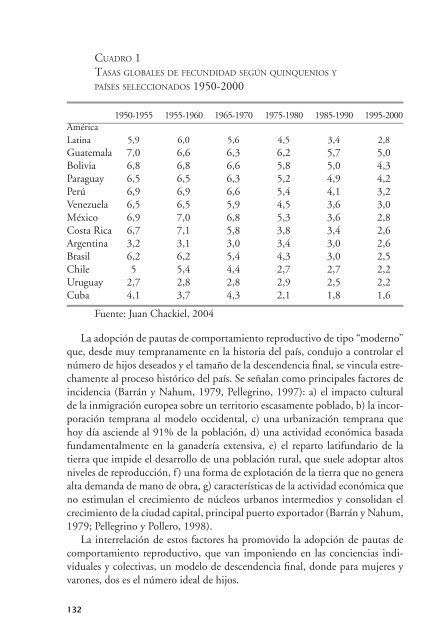Reproducción biológica y social de la población uruguaya
Reproducción biológica y social de la población uruguaya
Reproducción biológica y social de la población uruguaya
You also want an ePaper? Increase the reach of your titles
YUMPU automatically turns print PDFs into web optimized ePapers that Google loves.
132<br />
CUADRO 1<br />
TASAS GLOBALES DE FECUNDIDAD SEGÚN QUINQUENIOS Y<br />
PAÍSES SELECCIONADOS 1950-2000<br />
1950-1955 1955-1960 1965-1970 1975-1980 1985-1990 1995-2000<br />
América<br />
Latina 5,9 6,0 5,6 4,5 3,4 2,8<br />
Guatema<strong>la</strong> 7,0 6,6 6,3 6,2 5,7 5,0<br />
Bolivia 6,8 6,8 6,6 5,8 5,0 4,3<br />
Paraguay 6,5 6,5 6,3 5,2 4,9 4,2<br />
Perú 6,9 6,9 6,6 5,4 4,1 3,2<br />
Venezue<strong>la</strong> 6,5 6,5 5,9 4,5 3,6 3,0<br />
México 6,9 7,0 6,8 5,3 3,6 2,8<br />
Costa Rica 6,7 7,1 5,8 3,8 3,4 2,6<br />
Argentina 3,2 3,1 3,0 3,4 3,0 2,6<br />
Brasil 6,2 6,2 5,4 4,3 3,0 2,5<br />
Chile 5 5,4 4,4 2,7 2,7 2,2<br />
Uruguay 2,7 2,8 2,8 2,9 2,5 2,2<br />
Cuba 4,1 3,7 4,3 2,1 1,8 1,6<br />
Fuente: Juan Chackiel, 2004<br />
La adopción <strong>de</strong> pautas <strong>de</strong> comportamiento reproductivo <strong>de</strong> tipo “mo<strong>de</strong>rno”<br />
que, <strong>de</strong>s<strong>de</strong> muy tempranamente en <strong>la</strong> historia <strong>de</strong>l país, condujo a contro<strong>la</strong>r el<br />
número <strong>de</strong> hijos <strong>de</strong>seados y el tamaño <strong>de</strong> <strong>la</strong> <strong>de</strong>scen<strong>de</strong>ncia fi nal, se vincu<strong>la</strong> estrechamente<br />
al proceso histórico <strong>de</strong>l país. Se seña<strong>la</strong>n como principales factores <strong>de</strong><br />
inci<strong>de</strong>ncia (Barrán y Nahum, 1979, Pellegrino, 1997): a) el impacto cultural<br />
<strong>de</strong> <strong>la</strong> inmigración europea sobre un territorio escasamente pob<strong>la</strong>do, b) <strong>la</strong> incorporación<br />
temprana al mo<strong>de</strong>lo occi<strong>de</strong>ntal, c) una urbanización temprana que<br />
hoy día ascien<strong>de</strong> al 91% <strong>de</strong> <strong>la</strong> pob<strong>la</strong>ción, d) una actividad económica basada<br />
fundamentalmente en <strong>la</strong> gana<strong>de</strong>ría extensiva, e) el reparto <strong>la</strong>tifundario <strong>de</strong> <strong>la</strong><br />
tierra que impi<strong>de</strong> el <strong>de</strong>sarrollo <strong>de</strong> una pob<strong>la</strong>ción rural, que suele adoptar altos<br />
niveles <strong>de</strong> reproducción, f) una forma <strong>de</strong> explotación <strong>de</strong> <strong>la</strong> tierra que no genera<br />
alta <strong>de</strong>manda <strong>de</strong> mano <strong>de</strong> obra, g) características <strong>de</strong> <strong>la</strong> actividad económica que<br />
no estimu<strong>la</strong>n el crecimiento <strong>de</strong> núcleos urbanos intermedios y consolidan el<br />
crecimiento <strong>de</strong> <strong>la</strong> ciudad capital, principal puerto exportador (Barrán y Nahum,<br />
1979; Pellegrino y Pollero, 1998).<br />
La interre<strong>la</strong>ción <strong>de</strong> estos factores ha promovido <strong>la</strong> adopción <strong>de</strong> pautas <strong>de</strong><br />
comportamiento reproductivo, que van imponiendo en <strong>la</strong>s conciencias individuales<br />
y colectivas, un mo<strong>de</strong>lo <strong>de</strong> <strong>de</strong>scen<strong>de</strong>ncia fi nal, don<strong>de</strong> para mujeres y<br />
varones, dos es el número i<strong>de</strong>al <strong>de</strong> hijos.


